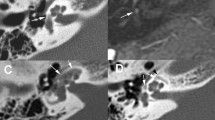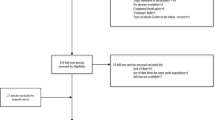Abstract
Auditory Brainstem Implants have been recommended as the gold standard in hearing rehabilitation of Neurofibromatosis Type 2 patients who lose hearing completely in both the ears and the cochlear nerves are not stimulable. Some patients have undergone cochlear implantation, in whom the cochlear nerve was spared during surgery or have undergone stereotactic radiotherapy preserving the function of the cochlear nerve. Here we report a case in whom we chose cochlear implantation prior to any definitive treatment for the tumour itself during the ‘wait and watch’ period. The reasons in favour of this approach have been discussed in this article. Post switch-on the implant is benefitting the patient satisfactorily and she is on regular follow up for monitoring the bilateral tumours.





Similar content being viewed by others
References
Evans DG (2009) Neurofibromatosis 2 Bilateral acoustic neurofibromatosis, central neurofibromatosis, NF2, neurofibromatosis type II. Genet Med 11:599
Dutt SN, Kumar A (2019) The methodology and electro-physiological classification of pre-operative trans-tympanic electrically-evoked auditory brainstem response (TT-EABR). Indian J Otolaryngol Head Neck Surg 71:1–4
Archbold S, Lutman M, Marshall DH (1995) Categories of auditory performance. Ann Otol Rhinol Laryngol 166:312–314
Allen MC, Nikolopoulos TP, O’Donoghue GM (1998) Speech intelligibility in children after cochlear implantation. Am J Otol 19:742–746
Linthicum H, Brackmann DE (1980) Bilateral acoustic tumours. A diagnostic and surgical challenge. Arch Otolaryngol 106(12):729–733
Abaza MM, Makariou E, Armstrong M, Lalwani AK (1996) Growth rate characteristics of acoustic neuromas associated with neurofibromatosis type 2. Laryngoscope 106:694
Asthagiri AR et al (2012) Mechanisms of hearing loss in neurofirbomatosis type 2. PLoS ONE 7(9):e46132 Epub 2012 Sep 26
Hoffman RA, Kohan D, Cohen NL (1992) Cochlear implants in the management of bilateral acoustic neuromas. Am J Otol 13:525–528
Dewan R, Pemov A, Kim HJ et al (2015) Evidence of polyclonality in neurofibromatosis type 2-associated multilobulated vestibular schwannomas. Neuro Oncol 17:566
Masuda A, Fisher LM, Oppenheimer ML et al (2004) Hearing changes after diagnosis in neurofibromatosis type 2. Otol Neurotol 25:150
Carlson ML, Breen JT, Driscoll CL, Link MJ, Neff BA, Gifford RH et al (2012) Cochlear implantation in patients with Neurofibromatosis type 2: variables affecting auditory performance. Otol Neurotol 33:853–862
Lambert PR, Ruth RA, Thomas JF (1992) Promontory electrical stimulation in postoperative acoustic tumour patients. Laryngoscope 102(7):814–819
Cueva RA, Thedinger BA, Harris JP, Glasscock ME (1992) Electrical promontory stimulation in patients with intact cochlear nerve and anacusis following acoustic neuroma surgery. Laryngoscope 102(11):1220–1224
Neff BA, Wiet RM, Lasak JM et al (2007) Cochlear implantation in the neurofibromatosis type 2 patient: long-term follow-up. Laryngoscope 117(6):1069–1072
Vincenti V, Pasanisi E, Guida M, Di Trapani G, Sanna M (2008) Hearing rehabilitation in neurofibromatosis type 2 patients: cochlear versus auditory brainstem implantation. Audiol Neurotol 13(4):273–280
Kida Y, Kobayashi T, Tanaka T, Mori Y (2000) Radiosurgery for bilateral neurinomas associated with neurofibromatosis type 2. Surg Neurol 53:383
Mathieu D, Kondziolka D, Flickinger JC et al (2007) Stereotactic radiosurgery for vestibular schwannomas in patients with neurofibromatosis type 2: an analysis of tumor control, complications, and hearing preservation rates. Neurosurgery 60:460
Samii M, Matthies C, Tatagiba M (1997) Management of vestibular schwannomas (acoustic neuromas): auditory and facial nerve function after resection of 120 vestibular schwannomas in patients with neurofibromatosis 2. Neurosurgery 40:696–706
Balasubramaniam A, Shannon P, Hodaie M et al (2007) Glioblastoma multiforme after stereotactic radiotherapy for acoustic neuroma: case report and review of the literature. Neuro Oncol 9:447
Wackym PA, Runge-Samuelson CL, Nash JJ et al (2010) Gamma knife surgery of vestibular schwannomas: volumetric dosimetry correlations to hearing loss suggest stria vascularis devascularization as the mechanism of early hearing loss. Otol Neurotol 31(9):1480–1487
Crane BT, Gottschalk B, Kraut M, Aygun N, Niparko JK (2010) Magnetic resonance imaging at 1.5 T after cochlear implantation. Otol Neurotol 31(8):1215–1220
Gubbels SP, McMenomey SO (2006) Safety study of the cochlear nucleus #24 device with internal magnet in the 1.5 Tesla magnetic resonance imaging scanner. Laryngoscope 116(6):865–871
Baumann R, Lesinski-Schiedat A, Goldring JE et al (1999) The influence of ionizing radiation on the CLARION 1.2 cochlear implant during radiation therapy. Am J Otol 20(1):50–52
Ralston A, Stevens G, Mahomudally E, Ibrahim I, Leckie E (1999) Cochlear implants: response to therapeutic irradiation. Int J Radiat Oncol Biol Phys 44(1):227–231
Klenzner T, Knapp F, Rohner F et al (2005) Influence of ionizing radiation on nucleus 24 cochlear implants. Otol Neurotol 26(4):661–667
Author information
Authors and Affiliations
Corresponding author
Ethics declarations
Conflict of interest
The authors certify that they have NO affiliations with or involvement in any organization or entity with any financial interest or non-financial interest in the subject matter or materials discussed in this manuscript.
Informed Consent
The relevant informed consent has been obtained from the patient for presenting this study.
Additional information
Publisher's Note
Springer Nature remains neutral with regard to jurisdictional claims in published maps and institutional affiliations.
Rights and permissions
About this article
Cite this article
Halyur, D.A., Rayanagoudar, P.H., Kumar, A. et al. Neurofibromatosis 2: Primary Modality of Hearing Rehabilitation with Cochlear Implant. Indian J Otolaryngol Head Neck Surg 73, 395–400 (2021). https://doi.org/10.1007/s12070-020-02321-x
Received:
Accepted:
Published:
Issue Date:
DOI: https://doi.org/10.1007/s12070-020-02321-x




